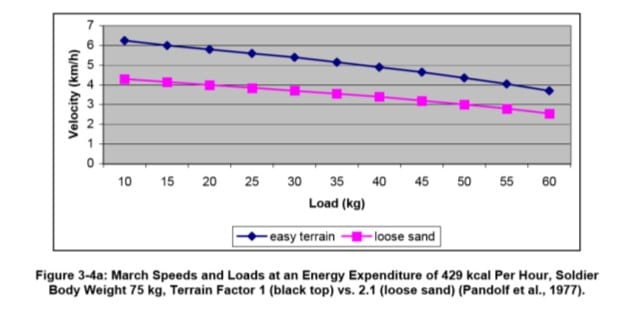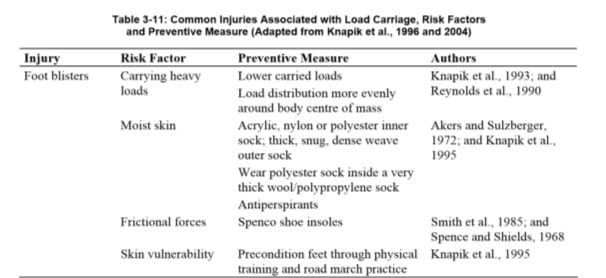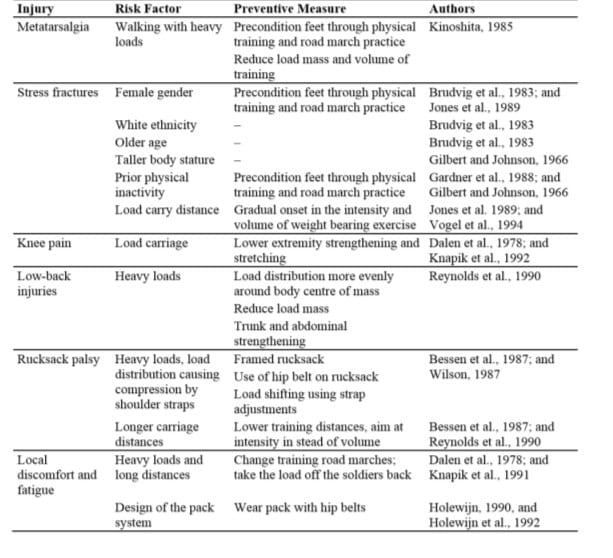Mike Prevost: Ruck Training Programs – PART 1
There’s quite a bit of published research on appropriate training for load-bearing marches, also known as rucking.
This article will serve to summarize and interpret those military research findings to provide background for Part Two, which will discuss how to apply the findings to a ruck training program.
Rucking Basics
So, what do you need to know to understand the types of training that benefit rucking? The risks involved? The basics? Here goes:
The load carried by the average foot soldier in combat is very heavy. The table below is from the NATO scientific technical report on load bearing marches:

You read that correctly 40kg . . . 88 lbs . . . and the loads are not getting lighter. The same report provides the table below from Afghanistan. Note that the loads are reported in kilograms:

Foot soldiers should be trained to be able to carry, at a minimum, 40% of bodyweight efficiently, and should be able to handle up to 75% of bodyweight for short periods of time.
This type of fitness is not likely to happen without significant planning. Left on their own for program design, soldiers are not likely to build the type of fitness to accomplish this task.
According to the available research, what factors lead to improved ruck performance?
- Height is an advantage. Taller soldiers take longer strides. They can also walk faster before having to change to a jog or run.
- Strength is an advantage. This is perhaps the biggest factor, especially for heavy loads. Upper body strength and lower body strength are both very important. For the upper body, core stability/strength as well as shoulder strength are important. For the lower body, hips are the most important, followed by strength around the knee joint and ankle.
- Aerobic fitness is an advantage, but not at the expense of strength. In this case, it is absolute, rather than relative aerobic capacity that is important. Relative = relative to bodyweight. Those who can produce the most power in non-load bearing activities (i.e., rowing, cycling) would likely do well at rucking. Skinny, fast runners are not likely to do well when loaded down with a ruck.
- Body fat reduces performance.
- Lean body mass improves performance (but reduces run performance). This is different from running, where increasing lean body mass does not help performance.
- Unloaded running ability is not important. This might seem counter intuitive but when you combine #s 2, 3 and 5 from above, it makes sense. However, most research used relatively heavy loads to test the relationship of running with ruck ability. It is likely that as loads get lighter (i.e., less than 20% of bodyweight), running ability is much more relevant.
What type of training has the most impact? Dr. William Kraemer, one of the leading researchers in the field of strength and conditioning, conducted a study looking at strength training and aerobic training on performance of a 3.2 km / 2 mile ruck with a 45 kg / 99 lb load. The table below summarizes his findings.

Aerobic training alone was useless. Strength training alone provided some benefit. The best results involved total body strength training and aerobic training, however, upper body strength training accounted for the majority of the strength training affect, a conclusion also reached by Knapik et. al in a review of the research literature. Keep in mind that “core” strength is considered upper body. Also, note that the Kraemer study used a heavy load and a short distance.
It is important to emphasize that upper body strength cannot be ignored in a good ruck training program.
The figure below shows the predicted relationship between load carried and the relative contribution of strength and aerobic fitness to ruck performance. The percentage contributions are notional and would vary from individual to individual. The important point of the figure is that at heavier loads, strength matters more than aerobic fitness.
Training for heavier loads would place an emphasis on strength training and heavy rucks.
At lighter loads, aerobic fitness matters more than strength. Training for lighter loads would place an emphasis on running and lighter, long duration rucks. Somewhere in the middle, they are both very important. Where that “middle” occurs will vary depending on the training of the individual.
Any load above 15% of bodyweight is going to start to require additional strength. By 30% of bodyweight, the strength requirement starts to become significant and a dedicated strength training program is recommended, as well as ruck training.

We know that strength training and running can improve ruck march ability and the heavier the ruck, the more important is the strength portion of the program.
What about just training with a ruck?
Other research showed that adding load bearing marches to a strength and aerobic training program further improved performance. It is hard to beat training specificity and ruck training is as specific as you can get to ruck performance. The optimal frequency of load-bearing march training has also been investigated. Twice per month was better than once per month but four times per month was not significantly better than twice. Keep in mind that this was within the context of a training program that also included running and strength training.
The minimum recommended frequency of load bearing marches in a program, if accompanied by a suitable strength and aerobic training program, is every two weeks. It is likely that if ruck training only is used (no running or strength training) more frequent rucks would be beneficial (i.e., 3 X weekly).
What do we know about ruck training frequency and intensity for a ruck program? The NATO report also discusses a study comparing weekly versus every two weeks and a program focused on duration versus one focused on intensity. The figure below shows the results.

The best results were obtained by:
Rucking weekly,
Focusing on heavier loads,
Carried as a series of intervals,
Over a shorter distance,
. . . Rather than long duration, lighter loaded rucks.
It is important to note that the performance criteria involved relatively light loads (17 kg/ 37.5 lbs) and a short distance (3.2 km / 2 miles). What conclusions can we draw from this research?
- Training programs should consist of both strength and aerobic training.
- Ruck training should be added at least two times per month, but once per week is better.
- Heavy, interval ruck training improves the ability to ruck heavy, as well as the ability to ruck lighter loads fast.
- Improving performance over short distances with heavy loads is best trained with an intensity program (heavy loading, short interval distances, i.e., 15-minute intervals with short rests).
- It is still unclear if heavy, interval ruck training is optimal for rucking moderate loads over long distances. If combined with a run training program, this effect is likely.
- Rucks should be progressively loaded (increase loading and distance over time).
- Strength training should focus on the whole body, not just the lower body.
- A mixture of long, lighter loaded rucks, as well as short, heavy loaded rucks is probably best if training for all distances and loads is desired.
- If a strength training and running program are also incorporated, rucking once per week is enough. It is still unclear if there is additional benefit to rucking more often in that context.
- If a ruck only program is employed (no strength training or running), rucking several times per week is likely to be better than once per week but the research literature is unclear on this issue.
As a final note with regards to #9 above, we cannot throw out the principle of specificity based on two studies. The safest conclusion we can draw from the NATO report is that ruck training once per week is enough to significantly improve. Whether more significant improvements would occur from rucking more often (i.e., three times per week) is unknown.
We do know that with strength training and endurance training, once per week is not optimal, so we might conclude the same with rucks. Also, the principle of specificity would compel us to consider replacing most or all of our running with ruck training if rucks are our objective, since unloaded run performance is not predictive of ruck ability. Hopefully more research will be conducted in this area in the future. Until then, replacing some running with additional rucks may be a good idea. If it is not logistically feasible, then a run program, supplemented with one ruck per week will do the job as shown by the research.
Ruck Speed
U.S. Army Field manual 21-18 states that an infantry company with gear can march on unimproved roads at:
4 kilometers (2.5 miles) per hour (24 minute mile)
32 kilometers (20 miles) in 24 hours
96 kilometers (60 miles) in 48 hours
These estimates minimize stragglers and ensure that most of the group will be combat ready at the destination. Moving much faster will result in more stragglers and many soldiers being too exhausted to effectively perform combat duties at destination.
Pandolf developed equations for predicting maximum sustained performance based on load, bodyweight and terrain. For prolonged (> five hours) marches, the average sustainable rate of energy expenditure was 430 calories per hour. This is for an average soldier (about 75 kg / 165 lbs) with average conditioning (VO2 max of 53 ml/kg/min, or a predicted 1.5 mile run time of 10:15).
Using that estimate, the figure below can be plotted. It estimates maximal sustained speed with different loads on two different surfaces. Notice that the surface has a larger impact than the load. Sand was one of the worst surface measured. Snow was the most difficult. Pandolf used old (1960s) estimates for the average soldier size. The reality is that the average soldier today is significantly heavier and would probably exceed both the calories/hour and velocities reported below by approximately 10%.
Bigger, stronger and more fit soldiers will go faster but the Army Field Manual 21-18 estimates are good numbers to work with for a group.

The tables below show the predicted maximum sustained speeds for a 75 kg / 165 lb male and 60 kg / 132 lb female. These are predictions for medium and long duration (2.5 – 6.5 hour) rucks. This is on the most ideal surface, a paved road.

Note:
5.5 km/h = 3.4 mph, or 17:30 per mile
5.0 km/h = 3.1 mph, or 19:15 per mile
4.5 km/h = 2.8 mph, or 21:30 per mile
4.0 km/h = 2.5 mph, or 24:00 per mile
Pandolf also measured energy expenditure on two surfaces at different speeds and loads. The data are in the figure below. Expenditures of 800-1000 calories per hour would only be sustainable for five-to-ten minutes for most soldiers. The 600 calorie/hr line might be sustainable for one-to-two hours, while 300-400 is more reasonable for long duration rucks (>five hours).

Finally, putting all of that information together, the table 3-14 can be constructed. It shows predicted time in minutes for different loads and surfaces.

Again, there will be significant individual variability, but these estimates can help you get in the right ballpark. The only way most soldiers will be able to sustain a rapid pace (>6km/hr or approx 4 mph) is by carrying a lighter load (<35% bodyweight) or by rucking shorter distances (<two hours).
Injuries
As with any endurance activity, overuse or biomechanical injuries are common. Knapic et. al. (1996) provided the table below after reviewing the literature.


One factor that they do not mention in the table, that is always recommended by experienced soldiers, is to make sure that your boots fit and that they are broken in properly. The boots should be roomy enough to allow your feet to swell slightly but not so loose that your feet move around in them and cause blisters. Fitting boots for loaded marching takes expertise and patience: Boots are not always immediately comfortable.
Frequently, comfort is increased once the boots are broken in. For leather boots, the break in period can be shortened by soaking the boots in the bathtub and then wearing them around the house for a few hours, with frequent sock changes. Then apply polish or leather treatment. Synthetic boots do not need as much of a break in period. Liberal application of foot powder and frequent changes of socks is helpful during a ruck. Many find the use of moleskin or duct tape on spots that frequently blister to be helpful. If you are not sure, it is wise to bring both, along with extra socks, just in case.
Walking gait should be natural, despite the load. Many have developed a “lazy gait” due to tight hip flexors and poor posture. This results in a forward pelvic tilt and excessive arch in the lower back, which in turn tends to result in a pronounced heel strike at foot fall with a locked knee. This type of gait exaggerates the impact forces of the load and is not efficient.
Flexible hip flexors and a higher cadence gait will result in a more natural, mid-foot strike with soft knees. This is the preferred gait when walking under a load. The way to achieve this is to focus on putting a slight tension in the abdominal muscles to rotate the pelvis to the correct position (posterior rotation), stand with a tall spine and chin tucked, then walk with a faster cadence and land softly with a slightly bent knee.
To tide you over until Part Two, here’s a video that talks you through some of the information presented above, but in greater depth:
In Part Two, we’ll look at two Ruck Training programs: The first program is more complete and is closer to optimal. The “80% solution” program is a minimalist program for those with minimal time to train.
[afl_shortcode url=” https://www.otpbooks.com/product/weight-training-for-police-officers-mark-roozen/?ref=20″ product_id=’3962′]
[afl_shortcode url=” https://www.otpbooks.com/product/dan-john-fundamental-human-movements/?ref=20″ product_id=’3978′]
[afl_shortcode url=” https://www.otpbooks.com/product/dan-john-now-what-video/?ref=20″ product_id=’19555′]
Tap into the Brains of Some of the World’s Leading Performance Experts
FREE Access to the OTP Vault

Inside the OTP Vault, you’ll find over 20 articles and videos from leading strength coaches, trainers and physical therapists such as Dan John, Gray Cook, Michael Boyle, Stuart McGill and Sue Falsone.
Click here to get FREE access to the On Target Publications vault and receive the latest relevant content to help you and your clients move and perform better.
- Van Dijk J. Chapter 3 – Common Military Task: Marching. Optimizing Operational Physical Fitness.RTO-TR-HFM-080.NATO Research and Technology Organisation. 2009.
- Kraemer, WJ, Vescovi, JD, Volek, JS, Nindl, BC, Newton, RU, Patton, JF, Dziados, JE, French, DN, and Hakkinen, K. Effects of concurrent resistance and anaerobic training on load-bearing performance and the Army Physical Fitness Test. Mil Med 169: 994–999, 2004.
- Knapik, J., Reynolds, K., Santee, W. R., Friedl, K., & Borden Institute (U.S.). (2010). Load carriage in military operations: A review of historical, physiological, biomechanical, and medical aspects. Washington, D.C.: Borden Institute.
- US Army Recruiting Command Pamphlet 601-25.
- US Army Field manual 21-18.
- Pandolf, K.B., Givoni, B., Haisman, B. and Goldman, R.F. (1977). Predicting energy expenditure with loads while standing or walking very slowly. Journal of Applied Physiology, 43: 577-581.
- Knapik, J.J., Johnson, R., Ang, P., Meiselman, H., Bensel, C., Johnson, W., Flyn, B., Hanlon, W., Kirk, J., Harman, E., Frykman, P. and Jones, B. (1993). Road marching performance of special operations soldiers carrying various loads and load distributions. Technical Report T14-93, United States Army Research Institute of Environmental Medicine, Natick, USA.
